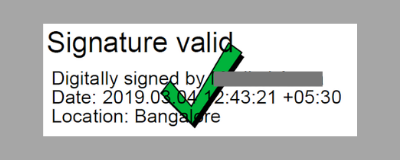
Click. Sign. Done.
Digital Signature and Electronic Signature are extremely easy and efficient to use. Though they are used interchangeably, both have their own differences. With technological advancements in the past centuries, it is much easier to secure your documents. So how do you do that?
The key difference between both these signing types is, digital signatures are used primarily to secure documents under the authorization of a certificate authority. Meaning, no forgery, no problems. Electronic signatures are used to sign contracts focusing on the signer’s intention. Just like signing a real document but, electronically.
In this article, we will go over a few more differentiating factors to thoroughly understand the uniqueness of digital signature and electronic signature.
Happy reading!
Digital signatures are a type of electronic signatures. Yes, both are used for document signing but a few unique factors are drawing a fine line between them. Before we dive into the distinct features of digital signatures and e-signatures let us understand each one in detail.
A digital signature, as the name suggests, is a technique to sign documents digitally. It validates the authenticity of a digital document while avoiding the routine pen-ink signing. They are considered the valid equivalent of a physical signature. The date and time stamping feature are an additional quality of digital signatures. This helps users to trace back the origins of when the documents were signed.
Using Public Key Infrastructure (PKI) and hash functions, digital signatures provide eminent security, solving the problem of tampering and forgery. Users sign their documents using a private key. The receiver receives the digital document with a copy of the user’s public key. If the receiver is unable to access the document using the public key, it means that the signature has undergone changes and is considered invalid.
A certificate authority provides its services to protect the integrity of the signature. To ensure safe digital singing, the two keys; public and private are stored safely with a reliable certificate authority.
While dealing with important contracts, organizations have security concerns about the authenticity of the signed document. Earlier, Notaries were responsible to verify the identity of the signer. Digital signatures tackle this by assuring their identity via a trusted third party, which is the Certificate Authority (CA). They are equivalent to adding a notarized element to your digital workflow, rendering them legal and secured.
Certificate authorities (CA) are a trusted body, responsible to verify the digital signer’s identity. Basically, the modern-day notaries. They bind the signer’s identity to a PKI based digital certificate allowing the signer to sign digitally using tokens or other cloud-based signing platforms.
Electronic signature technology is now replacing the traditional handwritten signing. Most e-signing solutions consist of using a stylus, mouse, or finger on a touchpad. They are extremely easy to create. One could use online tools or simply scan their handwritten signature. That too can be considered as an electronic signature.
Though e-signs oppose the age-old pen-ink contracts, they can be used to confirm the signer’s intention within the document. When compared to digital signatures, they are considered a less reliable option. This is due to the absence of a certificate authority. An electronic sign’s authenticity is constantly debated.
Since you now know the key differences. Do you know what digital or electronic signatures look like?
The following is an example of how a digital signature looks like. Here, the digital signature validates the identity of the signer with a Green tick along with a time and date stamp. This is the beauty of digital signatures; you can trace back the exact date and time it was signed.

This is what an electronic signature looks like. We are acquainted with signatures like these. Electronic signatures replicate the original signing format, digitally. The only drawback, you cannot verify if the signature is authentic or trace back its original date and time.

Learn more about How to sign using a digital signature
Summarizing the differences between a digital signature and an electronic signature in a tabular format
| Digital Signatures | Electronic Signatures |
|---|---|
| They are secured and highly reliable. | They are vulnerable and can be tampered with. |
| A Certificate Authority (CA) verifies the legal identity of the signature. | A verification body is absent. |
| Digital signatures use technology-specific approaches like PKI and hash functions for their creation. | E-signatures do not require a technology-specific process to be followed for their creation. |
| Digital signatures use the PKI cryptography system for encryption and decryption. | E-signatures can be accessed easily. |
| They are more authentic and can be verified. | They are less authentic and cannot be verified. |
| They consist of more security features. | They consist of fewer security features. |
| Users can trace the time and date the digital signature was created. | Users cannot trace the time and date the e-signature was created. |
Today, the use of digital and e-signatures are popular. However, using the apt technology in the correct situation can make or break the game. In a world full of digital fraud, it is necessary to choose the right tech. We hope the article was insightful and helped you choose the perfect solution for yourself!